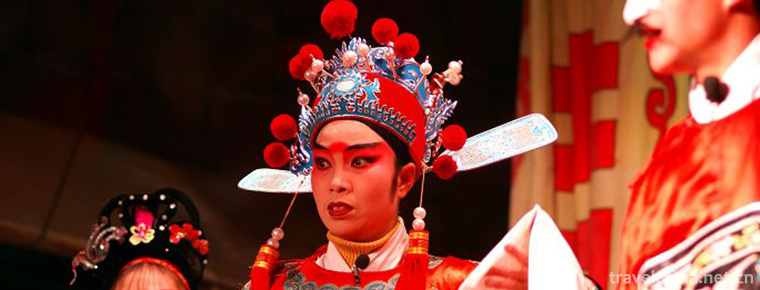Ming opera style
Ming opera style
Yiyang Opera, a local traditional drama in Yiyang County, Jiangxi Province, is one of the national intangible cultural heritage.
On May 20, 2006, Yiyang Opera was approved by the State Council of the People's Republic of China to be listed in the first batch of national intangible cultural heritage, numbered IV-5.
Cultural characteristics
The role of Yiyang tune is divided into Xiaosheng, Zhengsheng, Laosheng, Erhua, Sanhua, Xiaodan, Zhengdan, Laodan and so on. Its singing structure was initially composed of music and cards, accompanied by gongs and drums instead of orchestral accompaniment. The performer sings by one person and receives tunes by several people, thus forming a very distinctive singing mode of "unaccompanied song and gang tune" in the Ming Dynasty. Ye also developed a rolling tone to break the system of the combination of songs and cards, which further enhanced the dramatic and expressive power of the vocal music.
In the Ming Dynasty, literati and refined scholars seldom wrote, often adapted from the ready-made scripts of Kunshan Opera. The lyrics were popular, and the songs were easy to accept by the masses. Their singing style was solo singing by one person, accompanied by a group of people, only noisy gongs and drums and other percussion accompaniments, which was suitable for the field performance of Tongqu. Because it is widely popular among the people, and later developed into many tribes, long-term rivalry with Kunshan Opera. The legends of the middle and late Ming Dynasty are mainly Kunshan and Yiyang tunes.
Representational repertoire
Biyang Opera is divided into two categories: Liantai Opera and Legendary Book. The former includes Biography of the Three Kingdoms, Water Margin, Yuefei Biography, Mulian Biography and Fengshen Biography. The latter includes Qingmei Club, Gucheng Club, Dingtianshan, Jinmingji, Pearl Story and Water Selling Story.
Epidemic areas
Yiyang Opera is mainly inherited in Guixi, Wannian, Leping, Poyang, Fuliang, Shangrao and other areas in Jiangxi Province. It was spread in Anhui, Jiangsu, Zhejiang, Fujian, Guangdong, Hunan, Hubei, Yunnan, Guizhou and Beijing in the early and middle Ming Dynasty.
Inheritance and Protection
Inheritance value
Yiyang Opera is a wonderful flower of Chinese traditional culture. Its contribution to the development of Chinese opera, especially local opera, is irreplaceable.
Current situation of inheritance
Over the past two decades, due to various reasons, the inheritance of Yiyang Opera has entered a dilemma. The performing troop has been seriously aging, the name of the troupe has survived, and many excellent plays and singing tunes are on the verge of being lost. Even in its popular place, Yiyang Opera has been unable to meet the audience for many years and has fallen into an embarrassing situation that has been forgotten.
Heritage figures
Lin Xihuai, female, Han nationality, on May 8, 2018, was selected as the fifth batch of representative inheritors of national intangible cultural heritage projects, the representative project: Yiyang Tune.


-
1.Jiayuguan cultural relics scenic spot
Jiayuguan: World Cultural Heritage, National AAAAA Tourist Scenic Spot, National Key Cultural Relics Protection Unit, National Patriotic Education Demonstration Base.
Time 2018-12-12 -
2.Yilong Water Custom Park
Yilong Water Custom Park was built in 1996, covering an area of 100 hectares. It was solely operated by individuals and formally opened in June 1997.
Time 2018-12-22 -
3.Guilin Yijiang Margin Scenic Spot
Guilin Yijiang Rim Scenic Spot is situated on the northwest tour line of Guilin with long corridor. It is 32 kilometers away from the urban area (321 National Highway Lingui Wutong Town Section).
Time 2019-01-13 -
4.Lianhuashan Ski Resort
Located in Zhangzhen, Shunyi District, Beijing, Lianhuashan Skiing Ground covers an area of more than 1 million square meters and was opened on December 19, 2003.
Time 2019-01-29 -
5.Eight Delicacies Rice
The traditional name of Ningbo is Laba Festival Food. It is made from raw materials such as glutinous rice, bean paste, jujube paste, preserved fruit, lotus seed, rice kernel, longan, sugar and pig fa
Time 2019-03-25 -
6.Weaving and Dyeing Techniques of Felt and Printed Fabric
Uygur felt, printing and dyeing technology, Xinjiang Uygur Autonomous Region Turpan (now Turpan) local traditional skills, one of the national intangible cultural heritage.
Time 2019-05-04 -
7.Cutting Skill of Kaner Well
Kanerjing is the meaning of "well hole". It has been recorded as early as in Historical Records. It is called "well canal", while Xinjiang Uygur language is called "Kanerzi&qu
Time 2019-05-08 -
8.Baisha Xile of Naxi Nationality
Naxi Baisha Xile is also known as "Xiaoli at breaking time", "Xiaoli at breaking time", "Xili at breaking time", "Xili at breaking time" and "Xie Li at bre
Time 2019-06-06 -
9.Guan Zhong
Guan Zhong (about 723 BC - 645 BC) Ji surname Guan Shi, name Yi Wu, character Zhong, posthumous title, Yingshang (now Yingshang County, Anhui) A famous economist, philosopher, statesman and strategist
Time 2019-09-07 -
10.Chuanxindian earthquake site
Compared with Beichuan earthquake site, Yingxiu earthquake site and Hanwang town earthquake site, chuanxindian earthquake site in Shifang has unique advantages. It can fully reflect the great spirit of earthquake relief and has great protection and construction value.
Time 2020-11-05 -
11.Panzhihua after liberation
After liberation, Miyi County was established in some areas of Huili and Dechang in 1951, and renamed as Miyi County the next year, which was subordinate to Xichang District of Xikang province (due to its unique climate, rich products, especially rich in rice, and three crops a year,
Time 2020-12-14 -
12.Nanchong transportation
In 2019, the total mileage of Nanchong highway is 23100 km, including 574.06 km of expressway. The highway freight turnover was 10.921 billion ton kilometers, down 1.6% from 2018, and the highway passenger transportation turnover was 2.511 billion person kilometers, 17.7% lower than that in 2018.
Time 2020-12-17